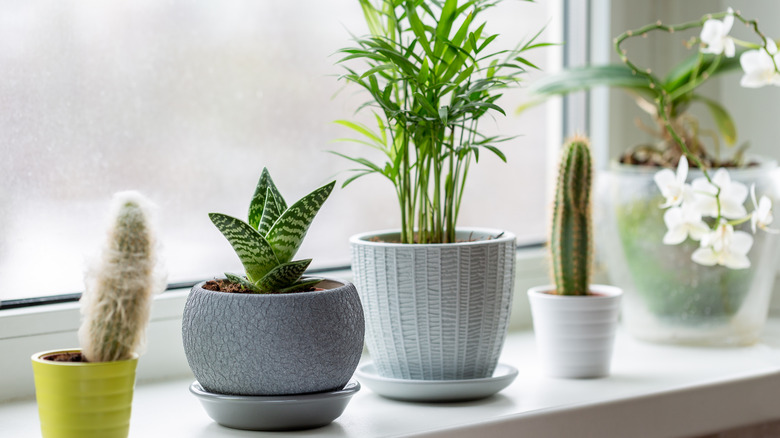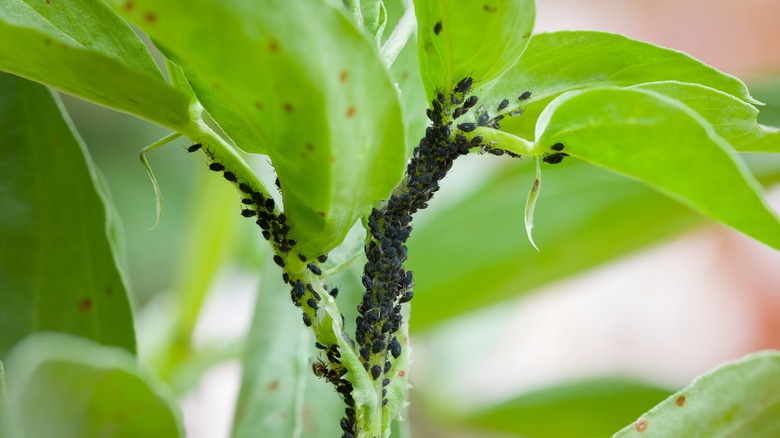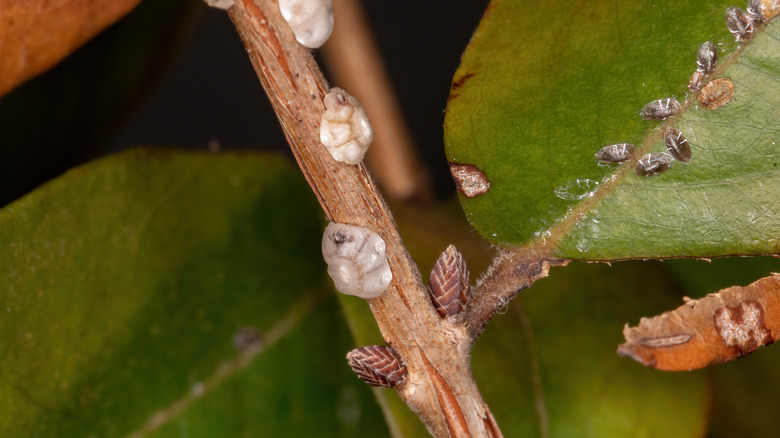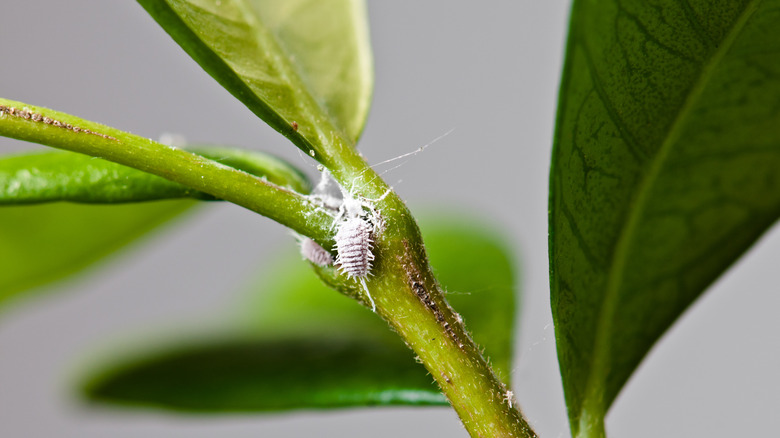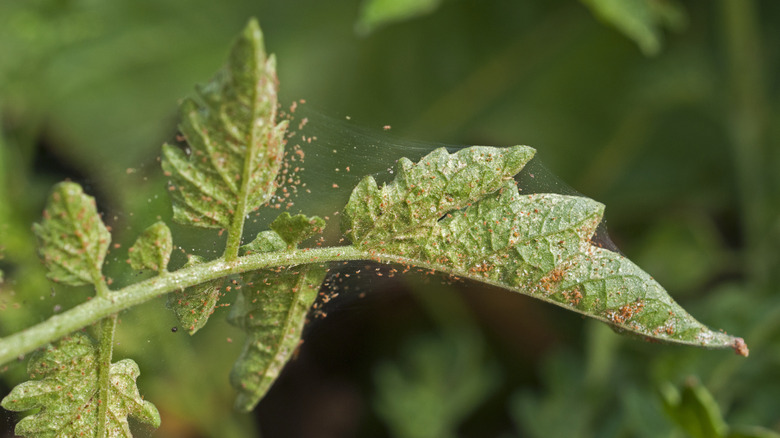The Common Pests That'll Wreak Havoc On Your Houseplants During Winter
You might think of aphids, scale insects, mealybugs, and mites as outdoor afflictions, but it's surprisingly easy for these creepy crawlies to find their way inside — especially during winter. Maybe some bugs settled into your houseplants while you were keeping them outside in the warmer months, and now they're coming indoors along with the plants. Or maybe they hitched a ride on your shoes or pets and realized your home was the perfect place to wait out the cold winter months. While environmental factors like wind, rain, and predators help keep these pests at bay outside, conditions indoors are favorable for them to thrive.
These hungry intruders feed on plant juices, creating wounds in the plant and damaging its cells in the process. They're so tiny that a single bug may not do much damage — but they reproduce fast. You may not notice an infestation until the pest population has exploded and is sucking the life out of your plant. Regularly checking your plants for pests is crucial to catch infestations early. Here are some of the most common pests that might trouble your houseplants this winter, how to spot them, and how to banish them for good.
Aphids
Aphids often cause problems in farms and orchards, but they'll also infest houseplants like hibiscus, chrysanthemums, and ornamental peppers. These small insects (under ¼-inch long) range in color from yellow and green to white, black, and brown. They especially love feeding on tender new shoots and leaves. If you notice leaves looking wilted, curled, or distorted, check underneath — aphids usually clump together in large groups on the undersides of leaves. You may also notice honeydew, a clear, sticky substance that aphids produce when they feed on plant sap.
The first step to removing these pests from your houseplant is placing it in the sink and rinsing it with a strong spray of water to dislodge as many of the bugs as possible. Then use an insecticide spray or horticultural oil to kill the rest. Another option that you can make with household supplies is a dish soap spray. Fill a spray bottle with water, add a few drops of dish soap, shake well, and spray the plant thoroughly. Keep in mind that some brands of soap work better than others, and some plants can be injured by dish soap. You can also purchase insecticidal soaps, which cost more but are less likely to damage sensitive plants. Either way, the solution will kill aphids only if it covers them, and it won't prevent eggs from hatching later. Repeat the process every few days for at least two weeks to make sure all the aphids are gone.
Scale insects
Hard or armored scales are like barnacles on your houseplant. They find a nice, juicy plant to latch onto, then grow a hard outer shell to protect themselves and their eggs. Because they don't move or produce honeydew and their shells are designed to blend in with plants, you may not notice armored scales until there are a lot of them and your plant's health has begun to decline. And because of their protective shell, they're very resistant to common insect sprays. Start by plucking off armored scales by hand or scrubbing them off with an old toothbrush, then spray your plant with horticultural oil. You can also try insecticide, but be sure to buy one designed specifically for hard scales — many products that work on other houseplant pests aren't effective on these tank-like parasites.
Unlike their hard-shelled cousins, soft scales move around plants and secrete honeydew. They still have a protective waxy cover, which makes it harder to kill them. The adults of the species are still susceptible to horticultural oils, and young stages that haven't yet grown their protective covers are susceptible to insecticide, oil, and soap sprays. Repeat the spray process for two to four months (the length of a scale generation) until the infestation is gone.
Mealybugs
Mealybugs are soft-bodied insects that resemble soft scales and produce honeydew. You probably won't see the tiny, winged males, but rather the tufty white females and the cottony material they produce when they lay eggs. They don't need males to lay eggs, because these pests can reproduce asexually — good news for them; bad news for your houseplants. Like scales, mealybugs feed on plant sap and cause a slow decline in the plant's health. If you see discolored leaves or flower buds that fall off before they bloom, you may have a mealybug problem.
Alcohol is often used to control mealybugs because it dissolves their waxy outer layer, causing their bodies to fatally dry out. Moisten a cloth, sponge, or cotton swab with rubbing alcohol and gently wipe the bugs off the leaves. You can also spray a diluted alcohol mixture (25% to 50% alcohol mixed with water), but be careful with this method because alcohol can burn some plants. Test the spray on a few leaves before applying it to the rest of the plant.
Mites
There are many species of mite, but the two-spotted spider mite is the most common houseplant pest. These aptly named arachnids have eight legs and build tiny webs. They feed by creating miniscule wounds in plant cells and sucking sap from them. These typically start out as white specks on the underside of leaves, but as the infestation grows, leaves will develop a more generalized gray or bronzed discoloration.
Because mites are so small, their webbing is often easier to spot than the mites themselves. Their small size also makes it easy for them to move from plant to plant, either by hitching a ride on people and pets or by being blown around in air currents. If you spot mites on one plant, treat them aggressively to prevent a house-wide infestation.
To get rid of these bugs, first move your plant to a sink and spray it thoroughly with water to dislodge as many mites and eggs as possible. Then fill a spray bottle with insecticidal soap, horticultural oil, or dish soap spray and douse your plant in it. Be sure to spray from all angles to catch mites hiding in leaf folds and crevices. Repeat the water rinse and spray process every week or so until you're sure the mites are gone.
